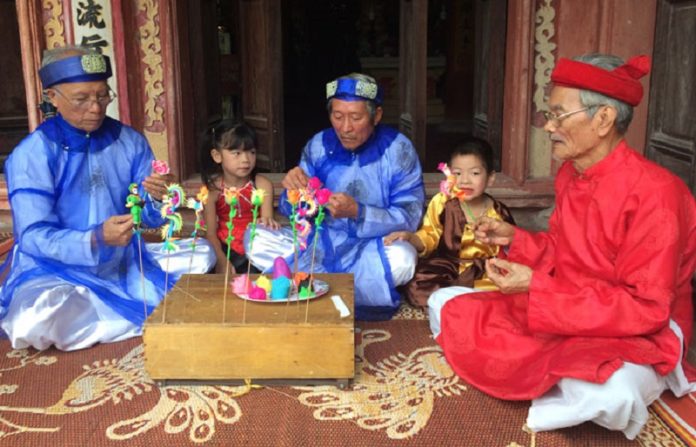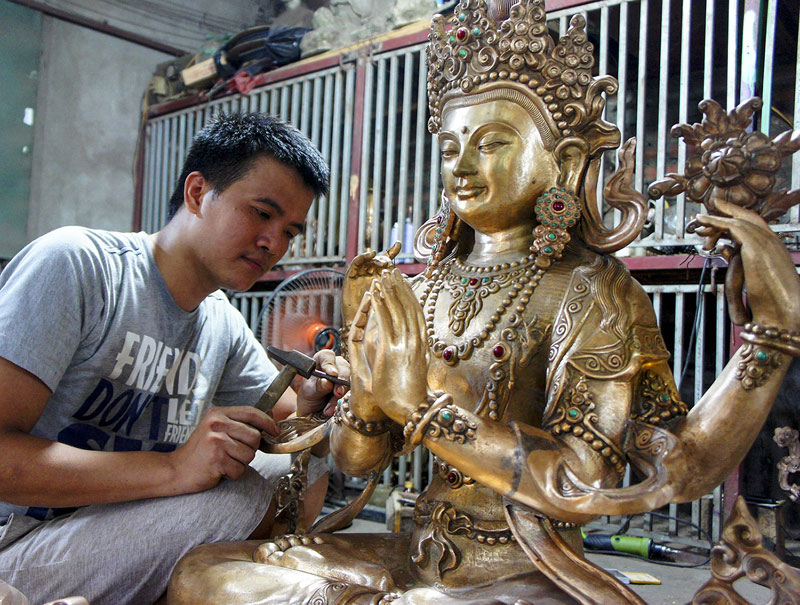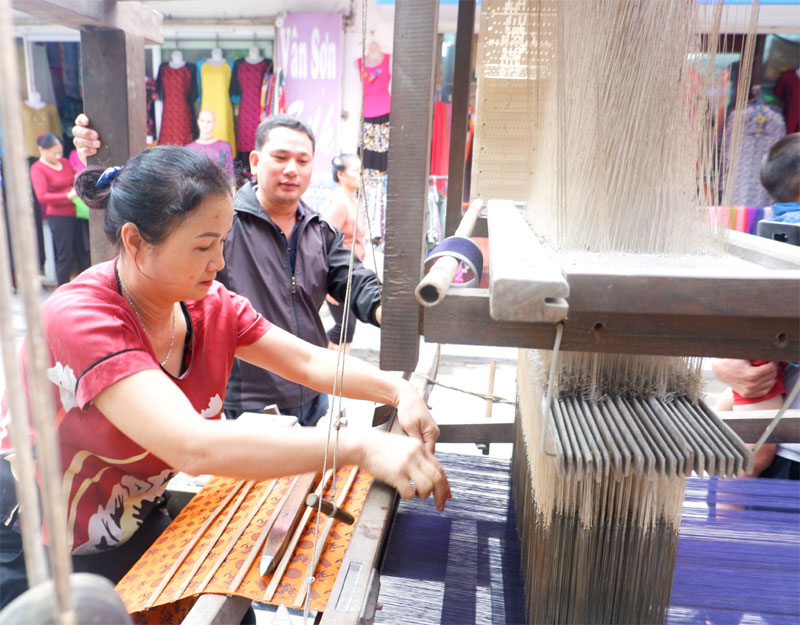Improving product production and quality and promotion is the way for traditional trade villages in Hanoi to adapt to modern life. During the past years, Hanoi had paid lots of efforts to bring traditional craft products closer to the public.
Bringing the trade out of the village
| Artisans from Xuan La village to perform To He making/ Photo: Nguyen Truong |
Hanoi has many trade villages such as Xuan La village (Phu Xuyen district) with about 300 years making to he (a traditional toy for children in Vietnam made from glutinous rice powder in form of edible figurine such as animals, flowers or characters in folk stories) or Trach Xa village (Ung Hoa district) with nearly 1,000 years of making ao dai (Vietnam’s traditional dress).
There are many similar traditional trades are being paid attention to preserve and promote their values in the modern time, such as bronze casting in Ngu Xa (Ba Dinh district) and Truong Tam (Thanh Tri district), silk weaving in Van Phuc (Ha Dong district) and Phung Xa (My Duc district), inlaid pearls and lacquer in Chuyen My (Phu Xuyen district); conical hat in Vinh Thinh, paper fan and carpentry in Chang Son and bamboo dragonfly in Thach Xa (Thach That district), and so on. After hundreds of years of preservation and development, the products of these traditional craft villages in Hanoi have gone beyond the frontier to reach both local and international customers.
Artist Dang Van Khuong (Xuan La traditional craft village) said with the support of the Hanoi Department of Culture and Information , every weekend artists in the village can perform and sell to he at Hoan Kiem lake pedestrian street. “Due to unfavorable traffic conditions, the craft village cannot welcome many tourists. Therefore, we always want to participate in programs and events in the center of Hanoi and other provinces and cities to introduce and promote Xuan La’s products,” he said.
| An old artisan from Ao dai Trach Xa village/ Photo: Van Phuc |
Meanwhile, Mr. Nghiem Van Dat, an ao dai tailor in Trach Xa village shared in the village there are more than 500 households working in the traditional profession, which are succeeded from generation to generation. His children and many others have brought the profession to the center of Hanoi and opened tailor shops there.
Ao dai Trach Xa and to he Xuan La are presented at the “Festival of folk culture in contemporary life 2020” recently organized by the Hanoi Department of Culture and Information, along with many other traditional craft products. Held for the first time in 2019 with the event of Hanoi joining the UNESCO Network of Creative Cities, the festival is an opportunity for craft villages to introduce their products to a large number of people and tourists, contributing to preserve and restore traditional cultural values.
Traditional occupation: old and new
| An young artisan at bronze casting in Ngu Xa trade village in Ba Dinh district, Hanoi/ Photo: Van Phuc |
Speaking at the opening of the Festival of folk culture in contemporary life 2020, Mr. To Van Dong – Director of the Hanoi Department of Culture and Information, emphasized: “The promotion of folk cultural heritages in contemporary life is not only to preserve the original values, but also develop these good values so that the culture not only brings spiritual values to the people but also contributes to socio-economic development, innovative startup association for young people and becomes a foundation for us in the global integration.”
To he of Xuan La village is now much different than before, with other ingredients added to make the toys last longer. The characters have also been changed to suit children’s favour today. To he is not only a simple toy but has been “upgraded” into large-scale and valuable works of art. Only the traditional non-toxic rice flour material and the artist’s enthusiasm are unchanged.
“In addition to small to he, we always actively study and create to produce larger works such as models of cultural and historical relics and stories. Our village has made a Vietnamese record for the largest model of a dragon and a turtle with a weight of about 300kg,” Mr. Dang Van Khuong shared.
| A silk weaving demonstration in Van Phuc silk village in Hanoi/ Photo: Bich Hoi |
Mr. Vu Duc Khuyen, a 26-year-old artisan with more than 10 years working with the mosaic profession in Chuyen My commune, Phu Xuyen district said: “Since I was in grade sixth, every summer vacation time I was being trained with the traditional trade to preserve it for the family. The original profession was pearl mosaic, but now it has turned to snail mosaic to make it more durable. Not everyone likes this product, so we have to be creative and import new materials from abroad for better quality.”
Assoc.Prof.Dr Do Van Tru – Chairman of the Vietnam Cultural Heritage Association said that not all of the old things are always good. “Regarding folk culture, things that are no longer appropriate in the modern time should be removed or improved, only keeping the most important value. For example, nowadays, agricultural tools are no longer popular so that the craftsmen have to increase their value and aesthetics to turn them into decorative products and gifts. Many traditional professions have been promptly adapted to the new context, such as forge in Da Sy village or wooden furniture making in Dong Ky village. Traditional trade must always be associated with contemporary life, going with development and change.”








